 Champions #1 — Writer: Mark Waid; Pencils: Humberto Ramos; Inks: Victor Olazaba; Colors: Edgar Delgado
Champions #1 — Writer: Mark Waid; Pencils: Humberto Ramos; Inks: Victor Olazaba; Colors: Edgar Delgado
Jessica Jones #1 — Writer: Brian Michael Bendis; Art: Michael Gaydos; Colors: Matt Hollingsworth
Cage! #1 (of 4) — Writer/Penciller: Genndy Tartakovsky; Inks: Stephen DeStefano; Colors: Scott Wills
Death of X #1 (of 4) — Writers: Jeff Lemire and Charles Soule; Art: Aaron Kuder; Colors: Morry Hollowell
Of the Marvel debuts this week, Champions has gotten the biggest push, with its top- tier creative team and diverse young social-justice-warrior cast. Waid’s been writing the core three — Ms. Marvel, the Miles Morales Spider-Man, and Nova — for a while as part of All-New Avengers, and developing their characters and relationships, so they make a logical starting point; the Amadeus Cho Hulk and Viv, the daughter of the Vision, complete the set (so far; having the young Cyclops on the cover suggests that he’ll be coming along soon, and the end of this issue has a couple of other teen — and one pre-teen — candidates). Ramos is a good choice for the art — he’s got an open, cartoony style that makes everyone look appealing, and he can handle action with the best of them — while Waid delivers an affecting story that efficiently sets everything up, provides a rationale and a menace, and ends with a call to arms: this is a textbook example of how to do a first issue right. Jessica Jones is more of a return than a debut, and in fact it looks a lot like her previous solo book, Alias, with her co-creators Bendis and Gaydos both back on board. That previous series opened with a damaged Jessica but finished with a happy ending; sadly, here she’s back to
tier creative team and diverse young social-justice-warrior cast. Waid’s been writing the core three — Ms. Marvel, the Miles Morales Spider-Man, and Nova — for a while as part of All-New Avengers, and developing their characters and relationships, so they make a logical starting point; the Amadeus Cho Hulk and Viv, the daughter of the Vision, complete the set (so far; having the young Cyclops on the cover suggests that he’ll be coming along soon, and the end of this issue has a couple of other teen — and one pre-teen — candidates). Ramos is a good choice for the art — he’s got an open, cartoony style that makes everyone look appealing, and he can handle action with the best of them — while Waid delivers an affecting story that efficiently sets everything up, provides a rationale and a menace, and ends with a call to arms: this is a textbook example of how to do a first issue right. Jessica Jones is more of a return than a debut, and in fact it looks a lot like her previous solo book, Alias, with her co-creators Bendis and Gaydos both back on board. That previous series opened with a damaged Jessica but finished with a happy ending; sadly, here she’s back to 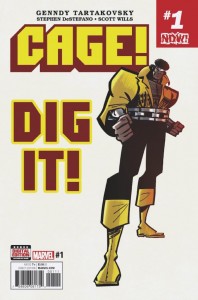 square one: just being released from jail, apparently separated from husband Luke Cage, and with something terrible, and unrevealed so far, in her recent past that’s driven her back to solo private-investigator work. If you were a fan of Alias, you’ll love this too; it has the same crime/noir grittiness, like Raymond Chandler but set in the Marvel superhero world, with Gaydos’s darkly-textured art the perfect complement for it. Champions is very good, with its mainstream-superhero brightness, but this just might be the better comic. The new mini-series Cage! features, of course, Luke Cage, but he’s as far from the Luke in Jessica Jones as could be: instead, creator Genndy Tartakovsky (Samurai Jack, Dexter’s Laboratory) is going for a classic ’70s Shaft/blaxploitation feel, with his trademark exaggerated/animation style. It’s a unique vision, although Tartakovsky, a Russian-American born in Moscow, may not appreciate the old American racial minefield he’s playing in: some of the panels skate close to minstrel-show stereotypes. Will that cause controversy, or will the book’s general good humor and sky-high energy carry the day? Buy it and
square one: just being released from jail, apparently separated from husband Luke Cage, and with something terrible, and unrevealed so far, in her recent past that’s driven her back to solo private-investigator work. If you were a fan of Alias, you’ll love this too; it has the same crime/noir grittiness, like Raymond Chandler but set in the Marvel superhero world, with Gaydos’s darkly-textured art the perfect complement for it. Champions is very good, with its mainstream-superhero brightness, but this just might be the better comic. The new mini-series Cage! features, of course, Luke Cage, but he’s as far from the Luke in Jessica Jones as could be: instead, creator Genndy Tartakovsky (Samurai Jack, Dexter’s Laboratory) is going for a classic ’70s Shaft/blaxploitation feel, with his trademark exaggerated/animation style. It’s a unique vision, although Tartakovsky, a Russian-American born in Moscow, may not appreciate the old American racial minefield he’s playing in: some of the panels skate close to minstrel-show stereotypes. Will that cause controversy, or will the book’s general good humor and sky-high energy carry the day? Buy it and 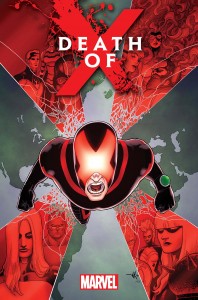 see; there’s certainly nothing else like it on the stands right now. That leaves Death of X, which is filling in what happened between the Inhumans and X-Men during the eight-month gap between the end of Secret Wars and the Marvel relaunches late last year, Short answer: the terrigen mists caused some mutant deaths, including one medium-significant one, and Scott wasn’t happy about it). With Lemire and Soule co-writing, it’s well done, and the art’s fine, although the it-all-happened-months-ago setup takes away a lot of its urgency; it just doesn’t seem to matter that much, especially in a week where the events in Jessica Jones and Champions do.
see; there’s certainly nothing else like it on the stands right now. That leaves Death of X, which is filling in what happened between the Inhumans and X-Men during the eight-month gap between the end of Secret Wars and the Marvel relaunches late last year, Short answer: the terrigen mists caused some mutant deaths, including one medium-significant one, and Scott wasn’t happy about it). With Lemire and Soule co-writing, it’s well done, and the art’s fine, although the it-all-happened-months-ago setup takes away a lot of its urgency; it just doesn’t seem to matter that much, especially in a week where the events in Jessica Jones and Champions do.
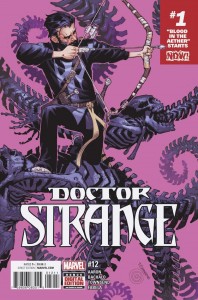 Doctor Strange #12 — Writer: Jason Aaron; Pencils: Chris Bachalo; Inks: Five Guys; Colors: Antonio Fabela
Doctor Strange #12 — Writer: Jason Aaron; Pencils: Chris Bachalo; Inks: Five Guys; Colors: Antonio Fabela
Amazing Spider-Man #19 — Writer: Dan Slott; Pencils: Giuseppe Camuncoli; Inks: Cam Smith; Colors: Jason Keith
Invincible Iron Man #14 — Writer: Brian Michael Bendis; Art: Mike Deodato; Colors: Frank Martin
The ongoing Marvel books for the week – Doctor Strange, having eliminated most of the magic in the world, of course now faces Doc with his greatest two enemies — and ends with a third one appearing, too. 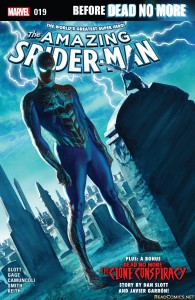 Aaron and Bachalo have been putting him through the wringer, depriving him of most of his easy mystical spells and weaponry and forcing him to fall back on grit, wit and a stubborn refusal to give up, and this continues that winning streak — fans of the upcoming movie should have two well-written, well-drawn trades, plus the most-recent issues, all ready for them after they see the film and want to catch what Doc’s been up to in this most-recent relaunch. Meanwhile, Amazing Spider-Man has one of those “Parker’s luck” stories where Spidey’s costumed and family obligations clash, with tragic results — all built around the looming “Dead No More” serial, wherein the Jackal’s new and improved cloning technology is starting to bring long-gone characters back to life; it’s the regular
Aaron and Bachalo have been putting him through the wringer, depriving him of most of his easy mystical spells and weaponry and forcing him to fall back on grit, wit and a stubborn refusal to give up, and this continues that winning streak — fans of the upcoming movie should have two well-written, well-drawn trades, plus the most-recent issues, all ready for them after they see the film and want to catch what Doc’s been up to in this most-recent relaunch. Meanwhile, Amazing Spider-Man has one of those “Parker’s luck” stories where Spidey’s costumed and family obligations clash, with tragic results — all built around the looming “Dead No More” serial, wherein the Jackal’s new and improved cloning technology is starting to bring long-gone characters back to life; it’s the regular 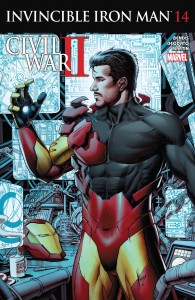 high-quality super-hero soap opera, from a team who’s been together for half a decade now, and knows just what it’s doing. Finally, Invincible Iron Man ends its current run (two new books, Infamous Iron Man and a new Invincible Iron Man, with Vincent von Doom and the teenage genius Riri in the suits, respectively, will be debuting in a month or two) with Tony and Carol, in civilian disguises, running into each other at an AA meeting and having a conversation to try to find common ground and end their by-now huge disagreement; it’s a tribute to Bendis and Deodato that a comic pretty much without any costumes or punching is still a character-rich read.
high-quality super-hero soap opera, from a team who’s been together for half a decade now, and knows just what it’s doing. Finally, Invincible Iron Man ends its current run (two new books, Infamous Iron Man and a new Invincible Iron Man, with Vincent von Doom and the teenage genius Riri in the suits, respectively, will be debuting in a month or two) with Tony and Carol, in civilian disguises, running into each other at an AA meeting and having a conversation to try to find common ground and end their by-now huge disagreement; it’s a tribute to Bendis and Deodato that a comic pretty much without any costumes or punching is still a character-rich read.
 Shade the Changing Girl #1 — Writer: Cecil Castellucci; Art: Marley Zarcone; Colors: Kelly Fitzpatrick
Shade the Changing Girl #1 — Writer: Cecil Castellucci; Art: Marley Zarcone; Colors: Kelly Fitzpatrick
Deadman: Dark Mansion of Forbidden Love #1 (of 3) — Writer: Sarah Vaughn; Art: Lan Medina; Colors: Jose Villarrubia
Batman #8 — Writer: Steve Orlando with Tom King; Art: Riley Rossmo; Colors: Ivan Plascencia
Nightwing #6 — Writer: Steve Orlando with Tim Seeley; Art: Roge Antonio; Colors:
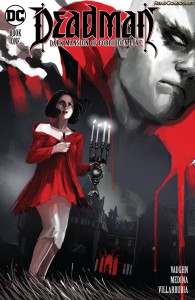 Only a handful of DC books this time, with Shade, the Changing Girl #1, the second of the Vertigo-like Young Animals imprint, the obvious star; set decades after the original two series, it’s about an bird-like alien girl on the planet Meta who, enamored with the legend of the original Shade and looking for adventure, steals his madness vest and goes to Earth, where she takes over the body of a comatose high school girl and tries to navigate high school, the Metan authorities searching for her, and the growing insanity that the madness brings to everything around
Only a handful of DC books this time, with Shade, the Changing Girl #1, the second of the Vertigo-like Young Animals imprint, the obvious star; set decades after the original two series, it’s about an bird-like alien girl on the planet Meta who, enamored with the legend of the original Shade and looking for adventure, steals his madness vest and goes to Earth, where she takes over the body of a comatose high school girl and tries to navigate high school, the Metan authorities searching for her, and the growing insanity that the madness brings to everything around 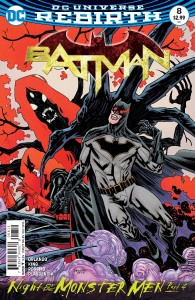 her. Trippy art and a solid story, weird in all the right ways, with the added bonus of a three-page Gilbert Hernandez story featuring the old DC sf character Space Ranger and his comic-relief alien sidekick, Cryll. Deadman is a square-bound, three-issue mini-series involving a woman, her husband and her business partner who move into a sprawling and, of course, haunted old mansion that he inherits; it’s told from her viewpoint, and she’s borderline psychic, so when Boston Brand shows up, drawn by the mansion’s mysterious power, she can, sometimes, see him,
her. Trippy art and a solid story, weird in all the right ways, with the added bonus of a three-page Gilbert Hernandez story featuring the old DC sf character Space Ranger and his comic-relief alien sidekick, Cryll. Deadman is a square-bound, three-issue mini-series involving a woman, her husband and her business partner who move into a sprawling and, of course, haunted old mansion that he inherits; it’s told from her viewpoint, and she’s borderline psychic, so when Boston Brand shows up, drawn by the mansion’s mysterious power, she can, sometimes, see him, 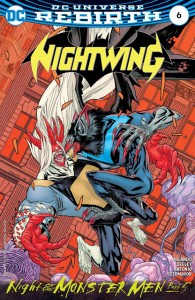 although she has no idea who or what he is. Detailed art from Medina, suitably Gothic and brooding, gives it just the right atmosphere to work. Batman and Nightwing offer parts four and five of the “Night of the Monster Men” crossover that’s been rolling through the bat-books this month, involving mutated giant monsters (including, now, Nightwing himself) stomping around Gotham. It’s efficient, mid-level pulp-action fun, and if you’re reading any of the bat-bnooks then you’ll need to read all of them to get the story — the reason why both DC and Marvel are so enamored with crossovers like this in the first place.
although she has no idea who or what he is. Detailed art from Medina, suitably Gothic and brooding, gives it just the right atmosphere to work. Batman and Nightwing offer parts four and five of the “Night of the Monster Men” crossover that’s been rolling through the bat-books this month, involving mutated giant monsters (including, now, Nightwing himself) stomping around Gotham. It’s efficient, mid-level pulp-action fun, and if you’re reading any of the bat-bnooks then you’ll need to read all of them to get the story — the reason why both DC and Marvel are so enamored with crossovers like this in the first place.
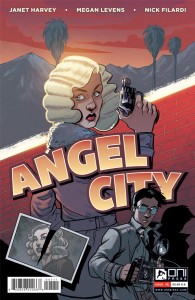 Angel City #1 (of 6) — Writer: Janet Harvey; Art: Megan Levens; Colors: Nick Filardi
Angel City #1 (of 6) — Writer: Janet Harvey; Art: Megan Levens; Colors: Nick Filardi
Archie Meets the Ramones #1 (of 1) — Writers: Alex Segura and Matthew Rosenberg; Art: Gisele Lagace; Colors: MA. Victoria Robado
Betty Boop #1 — Writer: Roger Langridge; Art: Gisele Lagace; Colors: MA. Victoria Robado
Cannibal #1 — Writers: J. Young and Brian Buccellato; Art: Matias Bergara; Colors: Brian Buccellato
Green Valley #1 (of 9) — Writer: Max Landis; Pencils: 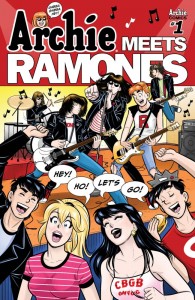 Giuseppe Camuncoli; Inks: Cliff Rathburn; Colors: Jean-Francois Beaulieu
Giuseppe Camuncoli; Inks: Cliff Rathburn; Colors: Jean-Francois Beaulieu
Moonshine #1 — Writer: Brian Azzarello; Art/Colors: Eduardo Risso
Shipwreck #1 — Writer: Warren Ellis; Pencils: Phil Hester; Inks: Eric Gapstur; Colors: Mark Englert
Eeesh — seven new first issues (and I flipped through a couple of others that didn’t make the cut), an indication that we’re in an upswing for comics publishing. Taking them in alphabetical order, Angel City, as its name 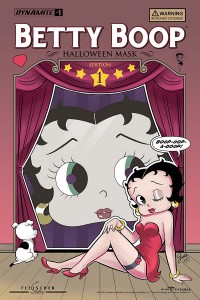 implies, is set in LA, in the 1930s, and is about a mob enforcer who’s investigating the death of an old friend; the twist is that the enforcer is female (as are the book’s writer and artist) — she and the friend came to California years ago to find their fortune in the film industry, and then their paths diverged. No new ground, but it’s a decent version of what it is, and fans of hard-boiled detective stuff should like it. Archie Meets the Ramones is exactly that, with the Riverdale group’s band being terrible, leading them to time-travel to NYC (courtesy of Sabrina) to get inspiration from the black-leather-clad proto-punk rockers. Not nearly as stupid as you might think, actually (the writers seem to be true fans), although it’s
implies, is set in LA, in the 1930s, and is about a mob enforcer who’s investigating the death of an old friend; the twist is that the enforcer is female (as are the book’s writer and artist) — she and the friend came to California years ago to find their fortune in the film industry, and then their paths diverged. No new ground, but it’s a decent version of what it is, and fans of hard-boiled detective stuff should like it. Archie Meets the Ramones is exactly that, with the Riverdale group’s band being terrible, leading them to time-travel to NYC (courtesy of Sabrina) to get inspiration from the black-leather-clad proto-punk rockers. Not nearly as stupid as you might think, actually (the writers seem to be true fans), although it’s 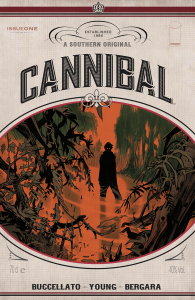 depressing that the Ramones are seen as an oldies group, listened to with nostalgia by Archie’s father. Weirdly, the art team, including the colorist, also is responsible for Betty Boop, a comic about another era entirely, and from a different company, and they demonstrate a chameleon-like flair for the contrasting styles (check out the cover to the Archie/Ramones book, by Giselle Lagace, and then look over at the Betty Boop one, also by her); they handle the classic Archie house style, even combined with the more-realistic Ramones, and then imitate the ’30s-style animation over in Betty Boop perfectly. It helps that the Boop comic is written by Roger Langridge (The Muppets; Popeye; Thor the Mighty Avenger; Snarked), who’s very good at taking
depressing that the Ramones are seen as an oldies group, listened to with nostalgia by Archie’s father. Weirdly, the art team, including the colorist, also is responsible for Betty Boop, a comic about another era entirely, and from a different company, and they demonstrate a chameleon-like flair for the contrasting styles (check out the cover to the Archie/Ramones book, by Giselle Lagace, and then look over at the Betty Boop one, also by her); they handle the classic Archie house style, even combined with the more-realistic Ramones, and then imitate the ’30s-style animation over in Betty Boop perfectly. It helps that the Boop comic is written by Roger Langridge (The Muppets; Popeye; Thor the Mighty Avenger; Snarked), who’s very good at taking  beloved but mined-out properties and making them sound simultaneously exactly like themselves, and brand-new (his Popeye was the best since the original Elsie Segar days). Cannibal is about “a virus that causes its victims to crave human flesh” (although the book’s at pains to point out that they aren’t, you know, zombies, since they’re still alive and can think and act otherwise normal — they just can’t stop themselves from eating people), and a small town confronting its arrival: derivative, but with enough twists and decent art to keep us interested. Green Valley is about a small group of expert knights who defend a small kingdom, and what happens wheh they screw up; the first issue’s pretty standard, although the editorial material promises lots of twists ahead, and it’s drawn by Giuseppe Camuncoli, who seems to be having a lot of fun drawing
beloved but mined-out properties and making them sound simultaneously exactly like themselves, and brand-new (his Popeye was the best since the original Elsie Segar days). Cannibal is about “a virus that causes its victims to crave human flesh” (although the book’s at pains to point out that they aren’t, you know, zombies, since they’re still alive and can think and act otherwise normal — they just can’t stop themselves from eating people), and a small town confronting its arrival: derivative, but with enough twists and decent art to keep us interested. Green Valley is about a small group of expert knights who defend a small kingdom, and what happens wheh they screw up; the first issue’s pretty standard, although the editorial material promises lots of twists ahead, and it’s drawn by Giuseppe Camuncoli, who seems to be having a lot of fun drawing 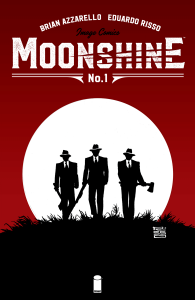 medieval armor and settings instead of his normal New York City superhero stuff for Amazing Spider-Man. Moonshine is notable for its creative team: Azzarello and Risso (100 Bullets), who offer a Prohibition-era tale about a New York mobster who, on an errand for his boss, comes down to the hills of West Virginia to talk a legendary, and expert, local moonshiner into letting them buy his wares to sell in NYC. This gives Azzarello a chance to do his hardboiled/pulp shtick, and Risso a chance to draw 1920s-style revenuers, hillbillies, tough guys and sharecroppers. Azzarello sometimes has trouble sticking the landings on his books (the individual scenes are knife-edged and compelling, but the overall plot sometimes gets tangles and loses its way), but here at the beginning it’s fine,
medieval armor and settings instead of his normal New York City superhero stuff for Amazing Spider-Man. Moonshine is notable for its creative team: Azzarello and Risso (100 Bullets), who offer a Prohibition-era tale about a New York mobster who, on an errand for his boss, comes down to the hills of West Virginia to talk a legendary, and expert, local moonshiner into letting them buy his wares to sell in NYC. This gives Azzarello a chance to do his hardboiled/pulp shtick, and Risso a chance to draw 1920s-style revenuers, hillbillies, tough guys and sharecroppers. Azzarello sometimes has trouble sticking the landings on his books (the individual scenes are knife-edged and compelling, but the overall plot sometimes gets tangles and loses its way), but here at the beginning it’s fine,  and that art sure is pretty. That leaves Shipwreck, a new Warren Ellis series in his surreal-sf mode, about an Air Force pilot on some kind of experimental-propulsion test flight gone wrong, who’s now wandering through a shattered urban landscape having conversations with weird people, all of which may or may not be hallucinations (the title, and an Ancient Mariner-like opening sequence, suggest that he’s actually drifting in space somewhere). Nobody does this kind of creepy/portentous stuff as well as Ellis, and Hester’s straight-faced, realistic style makes the strange parts even stranger, so it should be fun to see where this leads.
and that art sure is pretty. That leaves Shipwreck, a new Warren Ellis series in his surreal-sf mode, about an Air Force pilot on some kind of experimental-propulsion test flight gone wrong, who’s now wandering through a shattered urban landscape having conversations with weird people, all of which may or may not be hallucinations (the title, and an Ancient Mariner-like opening sequence, suggest that he’s actually drifting in space somewhere). Nobody does this kind of creepy/portentous stuff as well as Ellis, and Hester’s straight-faced, realistic style makes the strange parts even stranger, so it should be fun to see where this leads.
 James Bond #10 — Writer: Warren Ellis; Art: Jason Masters; Colors: Guy Major
James Bond #10 — Writer: Warren Ellis; Art: Jason Masters; Colors: Guy Major
The Killer Inside Me #2 (of 5) — Writer: Devin Faraci, from the book by Jim Thompson; Art: Vic Malhotra; Colors: Jason Millet
Autumnlands #13 — Writer: Kurt Busiek; Art: Benjamin Dewey; Colors: Jordie Bellaire
 Paper Girls #10 — Writer: Brian K. Vaughan; Art: Cliff Richards; Colors: Matt Wilson
Paper Girls #10 — Writer: Brian K. Vaughan; Art: Cliff Richards; Colors: Matt Wilson
Ragnarok #10 — Writer/Artist: Walt Simonson; Colors: Laura Martin
The Shadow: The Death of Margo Lane #5 (of 5) —  Writer/Artist: Matt Wagner; Colors: Brennan Wagner
Writer/Artist: Matt Wagner; Colors: Brennan Wagner
The rest of the smaller-publisher stuff. James Bond is Ellis again, but in straight-up commercial mode, with Bond the kind of high-tech spy thriller dipped in politics that he covered in Red or that run of one-shots in Secret Avengers; this is the middle of the book’s third arc, and the first two collections are worth a look. The Killer Inside Me has none of Bond’s smooth justifications for  homicide; its narrator kills because, sometimes, when you’re cornered, it’s the most expedient option. This gets its energy from being a prototypical lurid paperback tough-guy novel (“It was like pounding a pumpkin. Hard at first and then suddenly it all went soft. It all gave way.”), an artifact of ’50s noir like Mickey Spillane. The Autumnlands is nearing the end of its third arc, introducing another human character and suggesting the world might have a
homicide; its narrator kills because, sometimes, when you’re cornered, it’s the most expedient option. This gets its energy from being a prototypical lurid paperback tough-guy novel (“It was like pounding a pumpkin. Hard at first and then suddenly it all went soft. It all gave way.”), an artifact of ’50s noir like Mickey Spillane. The Autumnlands is nearing the end of its third arc, introducing another human character and suggesting the world might have a 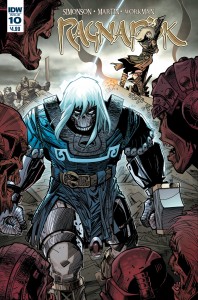 group of techno-avatar gods like in, say, Roger Zelazney’s Lords of Light. Not the best intro for new readers; you all should get the first trade instead, and enter Busiek and Dewey’s magic-enabled humanized-animal world from the beginning. Paper Girls showcases Cliff Chiang’s ability to deliver attractive close-up conversation work and then, every
group of techno-avatar gods like in, say, Roger Zelazney’s Lords of Light. Not the best intro for new readers; you all should get the first trade instead, and enter Busiek and Dewey’s magic-enabled humanized-animal world from the beginning. Paper Girls showcases Cliff Chiang’s ability to deliver attractive close-up conversation work and then, every 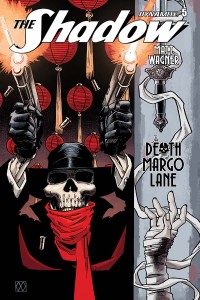 once in a while, wow us with a widescreen splash page. Vaughan makes sure to give him three this issue (two of which are classic), and a couple of heart-warming emotional beats to drive the conversation paerts, too. Ragnarok is Walt Simonson writing and drawing a post-twilight-of-the-gods Thor, and its inability to sell even ten copies an issue is just sad; you people all need to step up your game. The Shadow brings to a close Matt Wagner’s “Death of Margo Lane” serial, with a plot twist we all saw from a mile away, but the whole project has been so joyfully pulpy that we can forgive it.
once in a while, wow us with a widescreen splash page. Vaughan makes sure to give him three this issue (two of which are classic), and a couple of heart-warming emotional beats to drive the conversation paerts, too. Ragnarok is Walt Simonson writing and drawing a post-twilight-of-the-gods Thor, and its inability to sell even ten copies an issue is just sad; you people all need to step up your game. The Shadow brings to a close Matt Wagner’s “Death of Margo Lane” serial, with a plot twist we all saw from a mile away, but the whole project has been so joyfully pulpy that we can forgive it.



